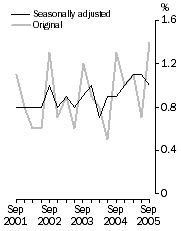PRICE INDEXES AND CONTRACT PRICE INDEXATION
SEPTEMBER KEY FIGURES
WPI-Quarterly changes, Total hourly rates of pay excluding bonuses

| WPI-Annual change: original, Total hourly rates of pay excluding bonuses - For selected industries

|
SEPTEMBER KEY POINTS
TOTAL HOURLY RATES OF PAY EXCLUDING BONUSES
QUARTERLY CHANGES (JUN QTR 2005 TO SEP QTR 2005)
- The index for all employee jobs in Australia increased by 1.0%, seasonally adjusted.
ANNUAL CHANGES (SEP QTR 2004 TO SEP QTR 2005)
- The seasonally adjusted increase through the year to September 2005 for all employee jobs in Australia was 4.2% (in trend terms, also 4.2%).
LABOUR PRICE INDEX EXCLUDING BONUSES
CHANGE FROM 2003-04 TO 2004-05
- The change in 2004-05 was 3.8%, with the private sector increasing by 3.6% and the public sector by 4.4%.
NOTES
ABS DATA AVAILABLE ON REQUEST
Original indexes are compiled for various combinations of state/territory, sector (private/public), broad industry group and broad occupation group. Seasonally adjusted and trend indexes are only compiled for total hourly rates of pay excluding bonuses for the private sector, public sector and all sectors. Indexes not included in this publication may be made available on request by telephoning Perth (08) 9360 5151.
FURTHER INFORMATION
More detailed information on the Labour Price Index (LPI) is available in Information Paper: Labour Price Index, Australia 2004 (cat. no. 6363.0) and Labour Price Index, Concepts, Sources and Methods, Australia (cat. no. 6351.0.55.001).
INQUIRIES
For further information about these and related statistics, contact the National Information and Referral Service on 1300 135 070 or David Taylor on Perth (08) 9360 5151.
COMMENTARY
WAGE PRICE INDEXES
Safety Net Review (SNR)
The Australian Industrial Relations Commission handed down its 2005 SNR decision on 7 June 2005 to increase federal full-time minimum award rates by $17 a week. All state jurisdictions handed down the same increase with varying date of effect, increases are likely to flow through mainly in the September and December indexes.
The $17 increase equates to a 3.6% wage increase for those jobs paid minimum award rates i.e. an increase to $484.40 per 38 hour week. In comparison, the May 2004 SNR increase was $19.00 a week, equivalent to a 4.2% increase.
Most of the impact of the SNR on the wage price index traditionally occurs in the September and December quarters.
Sector
The seasonally adjusted through the year movement for the private sector was 4.0%, with the public sector recording an increase of 4.7%.
Industry
In original terms, the industries with the highest rate of increase through the year to September quarter 2005 were Mining, Government administration and defence, Health and community services, and Cultural and recreational services which all recorded 5.0%. The Construction industry also had strong wages growth over the period with an increase of 4.7%. The lowest rate of increase was 3.2% which was reported by both Accommodation, cafes and restaurants, and Communications services.
NON-WAGE PRICE INDEXES
Annual and public holiday leave
In most states and territories there were minimal changes in annual leave and public holidays. The main exceptions were Victoria and Tasmania. In 2003-04, ANZAC Day fell on a Sunday and in 2004-05 it fell on a Monday. Unlike other jurisdictions, Victoria and Tasmania did not provide an additional day off in lieu in 2003-04. This was a major factor in these states having an increase of 7.7% for annual and public holiday leave for 2004-05.
Superannuation
The percentage change from the previous financial year increased from 3.7% in 2003-04 to 4.0% in 2004-05. The increase was driven by rises in wages, as the rate of superannuation changed for only a very small number of jobs.
Payroll tax
South Australia, Western Australia and the Northern Territory changed their payroll tax rates and/or payroll tax thresholds in 2004-05. South Australia reduced the rate of payroll tax from 5.67% to 5.5% in 2004-05, Western Australia reduced the rate of payroll tax from 6.0% to 5.5% effective from January 2005 onwards. The Northern Territory increased its payroll tax threshold from $600,00 to $800,000 in 2004-05 having cut the payroll tax rate the previous year.
The percentage change for the payroll tax index for South Australia for 2004-05 was 0.7%, compared to 4.4% for 2003-04. The equivalent figures for WA are 0.7% for 2004-05 and 3.8% for 2003-04. The Northern Territory recorded an increase of 0.8% for 2004-05 compared with 2.2% for the previous year.
 Print Page
Print Page
 Print All
Print All